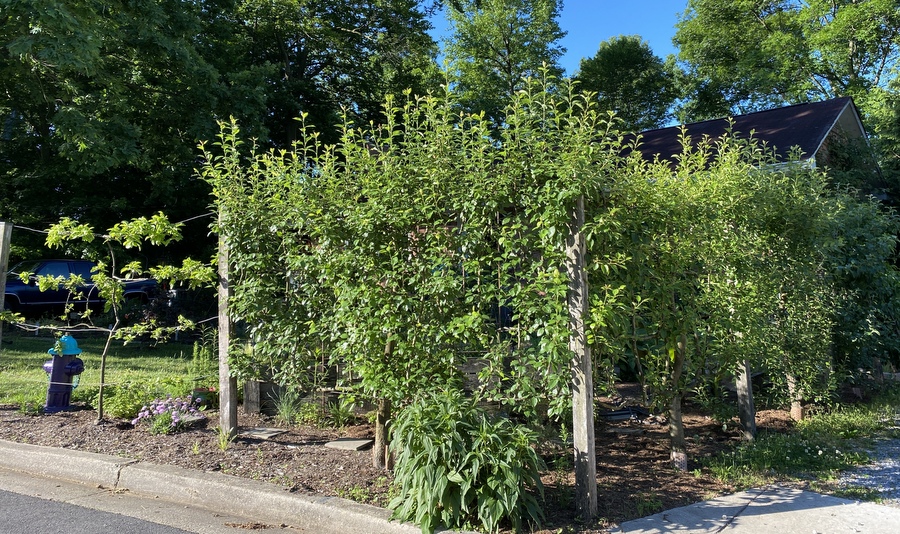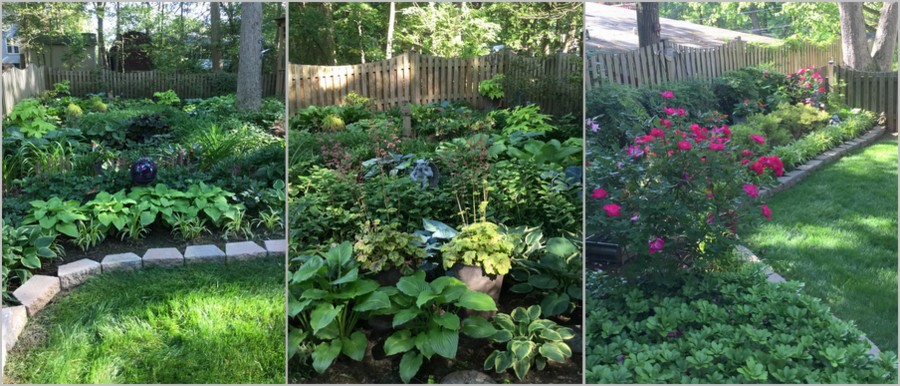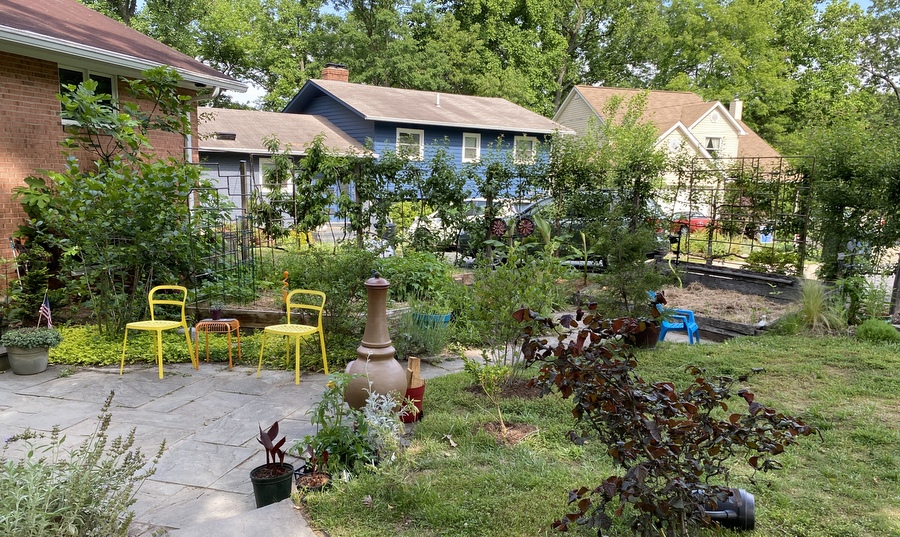As promised here and in an ad in the Greenbelt News Review, the Old Greenbelt Gardening Boosters and Greenbelt Online are changing things up this year, organizing a virtual garden tour instead of in-person events where numbers and distances would create a safety challenge.
The good news is that by going virtual, we have more gardens than ever, and there will be three virtual tours in 2020 – spring, summer and fall – so that local gardeners can be inspired by great plants and gardens throughout the growing season.
Plus, “tour-goers” may actually see some of the gardens in person, as they’re viewable from public space (sidewalks). Others are open to in-person visits with the gardener, who’ll be happy to answer questions. Check info for each garden.
The Gardens of Historic Greenbelt Homes (GHI)
Melissa Mackey
This is a rear garden and not visible from public space but Melissa welcomes visitors by appointment. Just email editor AT GreenbeltOnline.org to set it up.
From Melissa (president of the Beltsville Garden Club): “Although I love flowers, the contrasting layers of leaf texture and color are the most soothing, enchanting part of this garden for me. Close spacing knits plants gracefully together, shades the soil, and does not provide a foothold for weeds (except spring onions). Where do they all come from? In nature, plants grow up to each other’s elbows, and I enjoy seeing that in a garden. I do not like to see a bare garden in winter, so I mix in evergreens. I’ve happily found some that tolerate part sun – new this year, a silver Korean fir. Groundcovers that keep their leaves are welcome in winter.”

Rash Jain
To see the garden in person, just stop by 6D Research Rd. It’s all visible from the road.

View from the upstairs window.
Amethyst Dwyer
People are welcome to stop by 36J Ridge any time to see the front garden.
Above left “This year is my first attempt at a patio vegetable garden. 12 varieties of tomatoes (8 indeterminates, 4 determinates), 3 varieties of bush cucumbers, 2 varieties of bush beans, 3 varieties of kale, 4 varieties of lettuce, sugar snap peas, carrots, radish, cantaloupe, spinach, broccoli, arugula, parsley, cilantro, sunflower, green onions, nasturtium, mint, lemon balm, and basil. All grown from seed. I congregate the plants in the area where I receive the most sun. The nice thing about container gardening is that you are mobile and can move them around to accommodate this.”
Susan Harris
Located at 5J Ridge Road, the front garden and most of the back are visible from sidewalk. To see more and ask questions of the gardener, just email editor AT greenbeltonline.org.
From garden writer Susan: “Here in my front yard you’d never know there was a large AC under the window, it’s so well hidden by the fast-growing ‘Ogon’ spirea. On the right is a ‘Goshiki’ Osmanthus (evergreen) and the groundcover is comfrey.
“Also in the front yard, my big spring project has been replacing this sickly hedge of Arborvitaes (L) with a mix of vines growing on strong wires. I hope to show you that effect by the end of the summer, at least.”
“In the back, this is the small space between my porch and the neighbor’s privacy screen. Plants are 2 Ninebark shrubs, 3 native grasses between them (I don’t remember the name) and a mix of groundcovers : Sedum, Mondo Grass and Creeping Jenny. The Crossvine (Bignonia capreolata) is shown blooming on the right. It’s evergreen and native to this region.”
“At the far end of my back garden you see my new privacy screen that’s about 11 feet long, just 4′ high and elevated above the ground. (So while longer than the typical 8′ screen in GHI, it’s still less than the maximum allowed size of 48 sf). Most of these plants lose their leaves, so in the winter the screen does the work of hiding the garage area behind it.
Ken and Christine Loo
Check it out in person in the 19 Ridge Road Court.
Mary Fleming
Carol Griffith
See the garden in person at 55B Ridge Road.
Top: pink rhododendron. Above left: Hellebores did very well this year. Above right: Spiderwort.
Above left: purple primrose. Right: white trillium.
Mary Salemme
See this front garden in person at 1D Woodland Way.
Mary’s garden was created by former owner Richard Olsen, now director of the National Arboretum. She writes, “The Olsens left behind such a nice garden for me to take care of! I like how it seems there is always something blooming.”

Also in the front garden are Japanese Forest grass and phlox.
Above, May Apple or “Spotty Dotty.”
Anonymous
Above, front garden.
Above, in the back.
Charlene Lagerwerff
This garden is at 14 Ridge Road.
Suzette Agans
 “This spring, I’ve been able to spend a lot of time tending to the garden. I uncovered a path of stones that was buried by soil and plants, and trimmed and gave away some plants, so things are a little more tidy, but not too tidy. A deer has visited at least twice – I’ve come to expect that every spring and summer, even though I am on an interior path. All and all, happy to have my garden in these times.”
“This spring, I’ve been able to spend a lot of time tending to the garden. I uncovered a path of stones that was buried by soil and plants, and trimmed and gave away some plants, so things are a little more tidy, but not too tidy. A deer has visited at least twice – I’ve come to expect that every spring and summer, even though I am on an interior path. All and all, happy to have my garden in these times.”
Catherine Plaisant
CYCLE-BY PHOTOS IN GHI
Here are more GHI gardens, as seen from my bicycling trips around Old Greenbelt in April and May.
Above, a back yard as seen from a playground. Below, the same gardener’s cheerful front garden along Ridge Road.
Above, a mock orange blooming against the house. In the foreground is a blooming Baptisia.
Front yard dry garden. Very colorful front yard, especially on Memorial Day with the American flag on display.
Very colorful front yard, especially on Memorial Day with the American flag on display.
Above, in front of the GHI offices on Hamilton Place, Nepata blooms in the foreground in front of three ‘Ogon’ Spireas and a blooming Ninebark shrub.
Larger Gardens Just Outside of GHI
Mary Lou Williamson
Some of this garden at 58 Lakeside Drive can be seen from the street, and a bit from the path around Greenbelt Lake. To see more and ask questions of the gardener, email editor AT GreenbeltOnline.org to arrange a visit.
Above, the hillside garden overlooking Greenbelt Lake.
Above from left: Blood root; native Flame Azalea; Raspberry Corydalis.
Above: Lady in red fern, Trillium lutea backed by farfulgium – Britt Marie – with scattered English bluebells.

Connie Davis
To see this back garden in person, just go to 126 Northway and walk up the porch side to take a look. Or email editor AT GreenbeltOnline.org to arrange a visit with Connie.

Above and below – the back yard. Connie calls this “a shade garden with many hostas, astilbe, hellebore, Solomon Seal, daylilies. heuchera, aralia, liriope, camelias, and a few begonias.”
Anonymous
Email ezege@yahoo.com if you’d like to visit in person.
“When my husband and I bought our house in 2010, almost all grounds were overgrown with ivy, covering even the shrubs and bushes in the backyard. After a few years of pulling what felt like hundreds of trash bags of ivy, along with fighting invasive weeds like Japanese stilt grass, I finally started the layout of a future garden in 2018. To fight erosion issues, I began by installing a river rock staircase and a dry pond in the front yard, and soon salamanders and dragonflies moved in. 2019 saw some more installations: new fences, and some terraced beds. 2020 finally will be the year of planting. Being on a budget, growing some plants from seeds and propagating others by ground-layering or cuttings helped. Swapping plants with friends also proved to be an efficient way to “populate” the garden. There are still many empty spaces covered by nothing but mulch, but over time, my plants will grow and take over.
If you would like to take a closer look, please email ezege@yahoo.com.
Photo above: “Rock gardens prove to be efficient in dealing with the downhill slope prevalent in most of the backyard. In the background is the dark green canopy of Hosta Blessingham Blue. Native plants like ferns, Green and Golds, Bleeding Hearts and Appalachian Blue Violets found a home here as well. There are also some grasses and sedges: Sweet Flag Ogon, Morrow Sedge and Evergold. The low light-green groundcover is Kenilworth Ivy, blooming purple throughout the summer, and self-seeding for the next year; easily to propagate by spring cuttings. Never invasive, always reliable, Kenilworth Ivy is a beautiful little plant that could easily grow in a fairy garden … In the upper left, a future walking path is laid out with landscape foil but not completed yet.”
Above left: “One of the most fascinating (and beloved) plants in the garden is this Florida Anis Swamp Hobbit. A native of the Southern swamps, this plant was only discovered about ten years ago. The slow-growing dwarf shrub resembles a rhododendron, but the dark crimson star-like blooms set it apart. Bought at Behnke’s Nursery, this little guy leads a happy, partially shady life among astilbes, some hybrid daylilies, ferns, creeping saxifrage and sweet white violets.
Above right: The omnipresent azaleas in the backyard were inherited from the previous owners. I had to regroup them in order to create passageways or (like here) a river rock staircase. Creeping saxifrage (also known as Mother of Thousands), a gift from a generous friend, was planted this spring to the left of the staircase; its tiny white blossoms are beginning to form a lovely contrast to the pink and red azalea blossoms. On the right, pink ribbons mark areas where new plant seeds were added this spring; I hope they will show up soon. Lungwort and astilbes at the bottom of the staircase provide a nice green contrast to the azaleas.”
Above: “A view down the hill towards the backyard. Spanish Lavender gets ready to bloom, and is big enough to be divided next year. It is flanked by two pink Double Knockout roses. Behind them a Japanese Dwarf Maple, its leaves a lovely contrast to the plants around it, including the (still very tiny) Japanese Forest Grass in the center of the photo. Phlox and sedum groundcovers were planted this year to slowly spread and, over time, replace the mulch everywhere.”
Above, ” There are still areas of ivy left in the garden. Here I pulled some this spring to install a veggie bed. At least for this year, I decided to grow my veggies in fabric containers made of recycled plastic and bamboo, while onions and garlic grow straight in the ground. To attract pollinators and deter pests and critters, I also planted marigolds, nasturtiums, dill, catnip and rosemary. Most of the trellises are made of “free to take away” bamboo (thank you, unknown Greenbelt neighbor!) – a nice option that saved me quite some money in my first year of veggie gardening.”
Above, “As mentioned, this garden is still pretty much in the making. And since it is on a budget, I am “recycling” old gardening material from the previous owners as much as possible. Rocks, stepping stones, concrete blocks that once defined old gardening areas are carefully collected in the back of the garden, to be repurposed for new rock gardens, pathways, and staircases. But instead of just tossing them in piles, I rearranged them in little stone sculptures. Thus, while waiting for their new deployment, these stones bring serenity and amazing purpose to an otherwise rather boring part of the garden.”
Kim Rush Lynch
See this front-yard garden in person at 7 Lakeview Circle.
Above, front yard showing patio and in the distance, veg garden and fruit-tree espalier. Trees were from Edible Landscaping in Afton, VA.
 Above, the espalier from the street. The structure was built by Joe Lynch.
Above, the espalier from the street. The structure was built by Joe Lynch.
Sandra Lange
The address is 12 Pinecrest Court. Email salange1940 AT yahoo.com to arrange a visit.
Sandra writes that “Over the years, I have defined my color palette to purple, white and pink (although sometimes red, yellow and orange sneak in), and have focused on texture and color of leaves. I also have some tropicals such as banana trees in pots (they winter in my heated shed), hibiscus also in pots, orchids and bonsai plants. My pond features water lilies, lotus, colocasia and iris in addition to koi. The sound of the waterfalls, birds singing, frogs croaking, snakes sunning themselves creates my paradise.”
Above left, the arbor frames the entrance to the backyard with banana trees, ginger and other tropicals. Right – the shade garden.
Above left: Louisiana iris in water.Right: Wood orchids – they’re winter-hardy.
Above left, clematis in pot; right, Itoh peonies.
Richard Ernst
You’ll see this front-yard garden along Lastner Lane.
Above and below – front yard.
 Above, Knockout roses and perennials at Greenbelt Elementary School.
Above, Knockout roses and perennials at Greenbelt Elementary School.













































